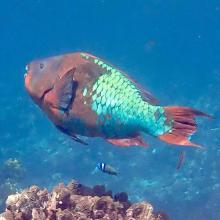Scarus guacamaia
Common name:
Rainbow parrotfish
Genus:
Scarus
Family:
Scaridae
Suborder:
Labroidei
Scarus guacamaia
Common name:
Rainbow parrotfish
Genus:
Scarus
Family:
Scaridae
Suborder:
Labroidei
Scarus guacamaia
Common name:
Rainbow parrotfish
Genus:
Scarus
Family:
Scaridae
Suborder:
Labroidei
Family (Animalia): Scaridae
Parrotfishes are a group of about 95 fish species regarded as a family (Scaridae), or a subfamily (Scarinae) of the wrasses. With about 95 species, this group's largest species richness is in the Indo-Pacific. They are found in coral reefs, rocky coasts, and seagrass beds, and can play a significant role in bioerosion.
Description
Parrotfish are named for their dentition, which is distinct from other fish, including other labrids. Their numerous teeth are arranged in a tightly packed mosaic on the external surface of their jaw bones, forming a parrot-like beak with which they rasp algae from coral and other rocky substrates (which contributes to the process of bioerosion).
Maximum sizes vary within the family, with the majority of species reaching 30–50 cm (12–20 in) in length. However, a few species reach lengths in excess of 1 m (3 ft 3 in), and the green humphead parrotfish can reach up to 1.3 m (4 ft 3 in). The smallest species is the bluelip parrotfish (Cryptotomus roseus), which has a maximum size of 13 cm (5.1 in).
Mucus
Some parrotfish species, including the queen parrotfish (Scarus vetula), secrete a mucus cocoon, particularly at night. Prior to going to sleep, some species extrude mucus from their mouths, forming a protective cocoon that envelops the fish, presumably hiding its scent from potential predators. This mucus envelope may also act as an early warning system, allowing the parrotfish to flee when it detects predators such as moray eels disturbing the membrane. The skin itself is covered in another mucous substance which may have antioxidant properties helpful in repairing bodily damage, or repelling parasites, in addition to providing protection from UV light.
Feeding
Most parrotfish species are herbivores, feeding mainly on epilithic algae. A wide range of other small organisms are sometimes eaten, including invertebrates (sessile and benthic species, as well as zooplankton), bacteria and detritus. A few mostly larger species such as the green humphead parrotfish (Bolbometopon muricatum) feed extensively on living coral (polyps). None of these are exclusive corallivores, but polyps can make up as much as half their diet or even more in the green humphead parrotfish. Overall it has been estimated that less than one percent of parrotfish bites involve live corals and all except the green humphead parrotfish prefer algae-covered surfaces over live corals. Nevertheless, when they do eat coral polyps, localized coral death can occur. Their feeding activity is important for the production and distribution of coral sands in the reef biome, and can prevent algal overgrowth of the reef structure. The teeth grow continuously, replacing material worn away by feeding. Whether they feed on coral, rock or seagrasses, the substrate is ground up between the pharyngeal teeth. After they digest the edible portions from the rock, they excrete it as sand, helping create small islands and the sandy beaches. The humphead parrotfish can produce 90 kg (200 lb) of sand each year. Or, on average (as there are so many variables i.e. size/species/location/depth etc.), almost 250 g (9 oz) per parrotfish per day. While feeding, parrotfish must be cognizant of predation by one of their main predators, the lemon shark. On Caribbean coral reefs, parrotfish are important consumers of sponges. An indirect effect of parrotfish grazing on sponges is the protection of reef-building corals that would otherwise be overgrown by fast-growing sponge species.
Analysis of parrotfish feeding biology describes three functional groups: excavators, scrapers and browsers. Excavators have larger, stronger jaws that can gouge the substrate, leaving visible scars on the surface. Scrapers have less powerful jaws that can but infrequently do leave visible scraping scars on the substrate. Some of these may also feed on sand instead of hard surfaces. Browsers mainly feed on seagrasses and their epiphytes. Mature excavating species include Bolbometopon muricatum, Cetoscarus, Chlorurus and Sparisoma viride. These excavating species all feed as scrapers in early juvenile stages, but Hipposcarus and Scarus, which also feed as scrapers in early juvenile stages, retain the scraping feeding mode as adults. Browsing species are found in the genera Calotomus, Cryptotomus, Leptoscarus, Nicholsina and Sparisoma. Feeding modes reflect habitat preferences, with browsers chiefly living in grassy seabed, and excavators and scrapers on coral reefs.
Recently, the microphage feeding hypothesis challenged the prevailing paradigm of parrotfish as algal consumers by proposing that:- “most parrotfishes are microphages that target cyanobacteria and other protein-rich autotrophic microorganisms that live on (epilithic) or within (endolithic) calcareous substrata, are epiphytic on algae or seagrasses, or endosymbiotic within sessile invertebrates.”
Reference: Wikipedia

